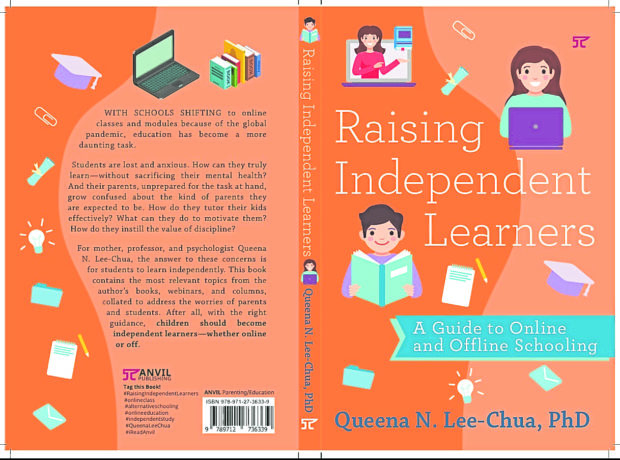
The biggest hindrance to online learning is not the lack of Wi-Fi access—students with limited internet access can always send USB drives to their schools and save the day’s lessons on them.
It’s also not the lack of content as there’s a wealth of information online for students and teachers.
It turns out the bedrock of online learning are still good old-fashioned study habits formed even before the pandemic. So parents, listen up: You are indispensable to developing your child’s study habits.
“There are students who are thriving, so it’s not true that everybody’s stressed out. Many are stressed out. But the students who are thriving, who are not stressed out, are the ones with solid study habits before the pandemic,” educator Queena Lee-Chua, Ph.D., told Lifestyle.
Since lockdown, Chua, a Math professor at Ateneo de Manila University in Quezon City, has conducted 68 webinars, 40 for the parents who have no idea what to do with their children’s online learning.
Chua said online learners don’t have to be on the honor roll to do well with online learning. With so many distractions today—not the least of them being their multiple social media (socmed) accounts—students need to manage their time well. And it’s not surprising that those who excel at time management are kids with healthy study habits.
Stressed students
“We Filipinos keep on blaming the pandemic, and, yes, I do blame the pandemic for many things. But the reason some students are so stressed out is that even before the pandemic, they had no idea how to do independent learning,” Chua said.
When students are stressed out, they develop anxiety; anxiety left unchecked becomes comorbid with depression, Chua said. So the cycle begins.
“Parents need to guide their children. They are busy working, they say, but they have to make time for their kids,” she said.
“Parents have this mistaken notion that the classes online are as long as the classes before COVID-19. They’re not. No school—and I’ve done more than 50 schools—has online classes from 7:30 a.m. to 4:30 p.m.”
Chua said many teachers have to cut down an hourlong class to 20 to 30 minutes online. Imagine what it’s like to stare at the computer screen for five hours when even Zoom meetings or webinars that stretch on for more than two hours challenge your concentration.
But there’s also another downside to online learning nobody is talking about. Chua said research has consistently shown that online reading is not the same as reading with actual paper in your hands. The same is true even for digital natives.
“Studies have shown that our concentration, our understanding and our retention in the memory are all decreased when we read online,” Chua said.
Nielsen Norman Group has research spanning more than 20 years to prove that people tend to scan, not read, online. Even the bookworms among us lose concentration and comprehension at some point as the eye moves from left to right on the blue light screen.
Digital eyestrain is not the only reason. Sure, dry eyes and bad lighting—even how you sit across a computer—can cause eyestrain. But Chua said those are not the only reasons we drift off even when we’re earnest about learning.
Family scheduling
“The reason for that is our eyesight has not evolved. The human eyesight has not evolved to handle reading online the way we do when we hold an actual paper,” Chua said. “Online reading is OK for simple tasks, for instance, if the content is very brief. But sometimes the content is not like this.”
For subjects that require heavy reading, Chua advises her students to print out the materials.
“What used to be 50 pages of required reading for Humanities essays has been reduced to 10 pages kasi hindi na nila kaya,” she said. “Another sad thing is the attention span is now worse. How can you focus on Immanuel Kant when you’re also doing socmed?”
Most distractions are self-inflicted, she said, like online surfing and gaming.
Parents need to ensure that their children are not online 24/7, she said. The scheduling has to be a family affair. Structure a home environment to make motivation a habit; discuss a doable routine for all. Give space for everyone, like using headphones. There should be a time for study, for sleep, for meals, for exercise.
“It also highlights the problems in family communication. Families that communicated well before the pandemic are also the families thriving now with online learning,” Chua said. “The parents of the students who are doing well are also good communicators.”
Students that have the biggest problems are those who cannot manage the structures of indiscriminate gadget use. (Students also request parents to lead by example since many parents also spend too much time on their gadgets.)
“Independent learning has nothing to do with the pandemic,” Chua said. —CONTRIBUTED
Chua’s new book, “Raising Independent Learners: A Guide to Online and Offline Schooling,” will launch on Nov. 21, 2 p.m., via livestream on the Anvil Publishing Facebook page.

